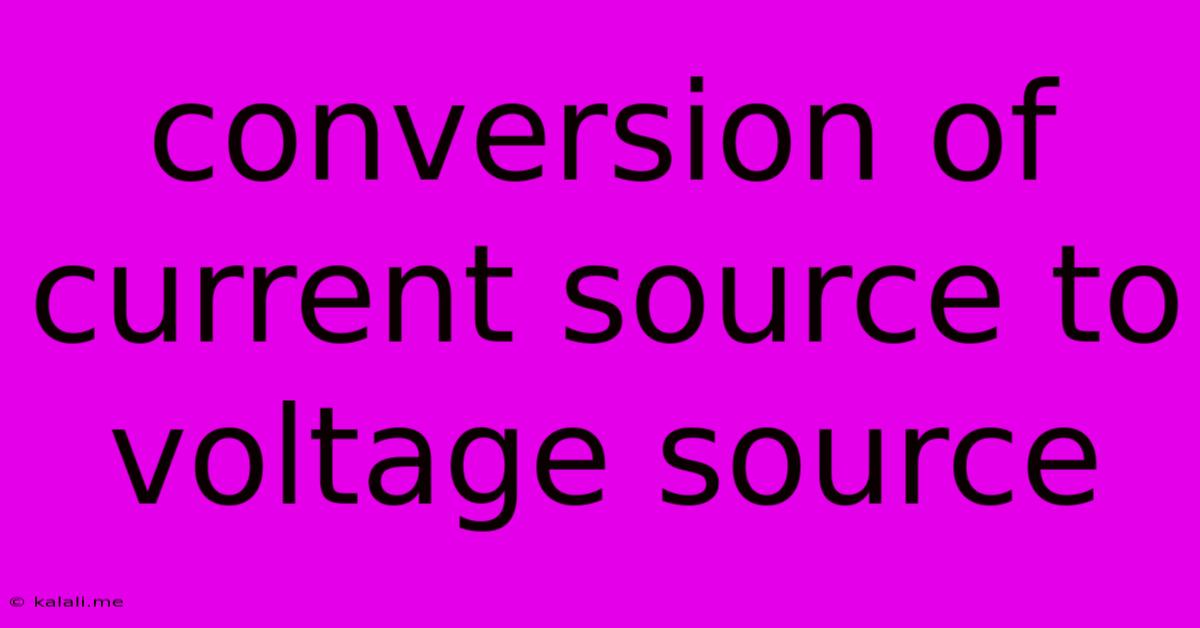Conversion Of Current Source To Voltage Source
Kalali
Jun 13, 2025 · 3 min read

Table of Contents
Converting a Current Source to a Voltage Source: A Comprehensive Guide
Meta Description: Learn how to effectively convert a current source to a voltage source using simple circuit analysis techniques. This guide covers the theory, steps, and practical applications of source transformation.
Current and voltage sources are fundamental components in electrical circuits. Understanding how to transform one into the other is a crucial skill for circuit analysis and design. This article will provide a clear and comprehensive guide on converting a current source to a voltage source, explaining the theory, steps, and practical applications.
Understanding Source Transformation
Source transformation, also known as source conversion, allows you to replace a current source in parallel with a resistor with an equivalent voltage source in series with the same resistor, and vice versa. This technique simplifies circuit analysis, particularly when dealing with complex networks. The key is maintaining the same voltage-current relationship at the terminals of the equivalent circuits.
The Theory Behind the Conversion
The transformation relies on Ohm's Law (V = IR) and the understanding of parallel and series circuits. A current source (I) in parallel with a resistor (R) produces a voltage (V) across its terminals equal to IR. This voltage, along with the same resistor (R), forms the equivalent voltage source.
Steps for Converting a Current Source to a Voltage Source
Here's a step-by-step guide on how to perform the transformation:
-
Identify the Current Source and Parallel Resistor: Locate the current source (I) and the resistor (R) connected in parallel to it. Ensure you're only working with the branch containing the current source and resistor that you're transforming. Other circuit elements should be considered separately.
-
Calculate the Equivalent Voltage: Use Ohm's Law to calculate the equivalent voltage (V) using the formula:
V = I * R. This voltage will be the value of your new voltage source. -
Replace the Current Source and Resistor: Remove the current source and replace it with a voltage source having the calculated voltage (V) in series with the same resistor (R). The polarity of the voltage source should be such that the current flow remains consistent with the original circuit. The positive terminal of the voltage source should be connected to the same node as the positive terminal of the original current source.
-
Verify the Equivalence: After the transformation, the voltage-current characteristics at the terminals should remain unchanged. You can verify this through circuit analysis techniques like nodal or mesh analysis.
Practical Applications and Examples
Source transformation is invaluable in various applications, including:
- Simplifying Complex Circuits: Transforming current sources to voltage sources (or vice versa) can significantly simplify complex circuit analysis by reducing the number of nodes or meshes. This can make applying Kirchhoff's laws much easier.
- Thevenin and Norton Equivalents: Source transformation is a crucial step in finding the Thevenin and Norton equivalent circuits, simplifying the analysis of large and complex networks.
- Circuit Design: It allows for flexibility in designing circuits, enabling engineers to choose the most suitable source type for a particular application.
Example:
Let's say we have a 2A current source in parallel with a 5Ω resistor. To convert it to a voltage source:
- Current (I) = 2A
- Resistance (R) = 5Ω
- Equivalent Voltage (V) = I * R = 2A * 5Ω = 10V
The equivalent circuit will consist of a 10V voltage source in series with a 5Ω resistor.
Limitations
While source transformation is a powerful tool, it's important to be aware of its limitations:
- Dependent Sources: The technique doesn't directly apply to dependent sources (sources whose value depends on other voltages or currents in the circuit). More advanced techniques are required for these cases.
- Non-linear elements: This transformation is only valid for linear circuits containing resistors and independent sources.
By understanding the principles and steps outlined in this guide, you can confidently convert current sources to voltage sources, thereby simplifying complex circuit analysis and enhancing your circuit design capabilities. Remember to always verify your transformed circuit to ensure equivalence.
Latest Posts
Latest Posts
-
Si Unit For Density Of Water
Jun 14, 2025
-
Which Of These Volcanic Eruption Types Is The Most Violent
Jun 14, 2025
-
Which Bone Is Not In The Middle Ear
Jun 14, 2025
-
What Is The Largest Cell In The Body
Jun 14, 2025
-
How Many Kg Is 350 Lbs
Jun 14, 2025
Related Post
Thank you for visiting our website which covers about Conversion Of Current Source To Voltage Source . We hope the information provided has been useful to you. Feel free to contact us if you have any questions or need further assistance. See you next time and don't miss to bookmark.